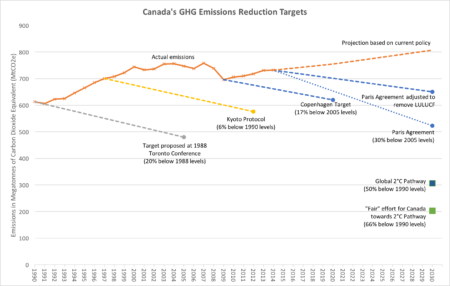I have rarely seen such a concise and numerically-backed summary of Canada’s climate change policy outcomes than this one from Steve Easterbrook’s blog in 2016:
Several things jump out at me from this chart. First, the complete failure to implement policies that would have allowed us to meet any of these targets. The dip in emissions from 2008-2010, which looked promising for a while, was due to the financial crisis and economic downturn, rather than any actual climate policy. Second, the similar slope of the line to each target, which represents the expected rate of decline from when the target was proposed to when it ought to be attained. At no point has there been any attempt to make up lost ground after each failed target. Finally, in terms of absolute greenhouse gas emissions, each target is worse than the previous ones. Shifting the baseline from 1990 to 2005 masks much of this, and shows that successive governments are more interested in optics than serious action on climate change.
At no point has Canada ever adopted science-based targets capable of delivering on its commitment to keep warming below 2°C.
In my July 2021 letter to Environment Minister Jonathan Wilkinson I defined the term “gapology” as: “the process going back to the Chrétien era of setting a GHG reduction target for political reasons and then performing economic analyses to compare potential mitigation measures and the GHG reductions expected to accompany them against the political target, always finding a gap in which some further action would be required.”
Trudeau’s net zero promise is an extension and reiteration of the gapology strategy: safely pushing accountability for meeting the target to long beyond his own time in office.
Related:
- Endless Canadian delay on climate change mitigation (2009 – yes, it had already been endless in 2009 *crying emoji*)
- Can Canada meet the Conservative GHG targets? (2009)
- GDP growth versus emissions growth in Canada
- Emissions drop from Canada’s biggest GHG polluters (2010)
- Canada’s climate plans a flop (2010)
- How to meet Canada’s climate targets (2010)
- Canada’s climate targets in 2012 (2012)
- Canada not on track to meet its (inadequate) climate targets (2013)
- The Paris Agreement, general aspirations versus specific targets (2018)
- Canada’s climate inadequacy (2019)
- Net zero climate targets (2020)
- Trudeau’s climate failure (2020)
- Canada submits new 2030 climate target (2021)


Today, Canadian governments face two major policy challenges: 1) the need to close the substantial gap between projected emissions reductions resulting from existing policy implementation and the national target of 17% below 2005 emissions levels by 2020; and 2) the need to establish a post-2020 mitigation target by 2015, arising from Canadian participation in the 2011 Durban Platform for Enhanced Action.
Macdonald, Douglas. Allocating Canadian Greenhouse Gas Emission Reductions Amongst Sources and Provinces: Learning from Germany and the EU. 2013. url: https://tspace.library.utoronto.ca/bitstream/ 1807/77153/1/AllocatingGHGReductions2013.pdf
Canadian oilpatch likely to surpass production record | CTV News
https://www.ctvnews.ca/business/canadian-oilpatch-likely-to-surpass-2022-s-production-record-but-only-slightly-1.6209552
The Intergovernmental Panel on Climate Change published its “synthesis report”, reviewing the scientific evidence relating to climate change. It reiterates scientists’ message that rising temperatures are already having more severe impacts than expected. To meet climate goals, greenhouse-gas emissions must peak in the next few years—but they are predicted to keep rising beyond then.
https://www.economist.com/the-world-this-week/2023/03/23/politics
What would it take for Canada to hit its climate targets? | CBC News
https://www.cbc.ca/news/politics/climate-change-emissions-oil-gas-trudeau-1.7025798